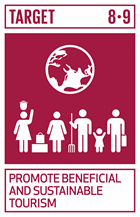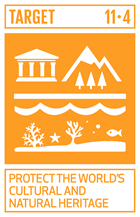Concept for the Curonian Spit Travel Guide
In the Curonian Spit and all over Lithuania there is no travel guide which introduces everyone to the OUV of the Curonian Spit. The history and information about the natural and cultural heritage of the Curonian Spit may be found either in guides of all Lithuania or in different kinds of books, depending on the topic.
There is no publication about UNESCO World Heritage site in a comprehensive and correct way, covering both Lithuania and the Russian Federation. In the travel guide the Curonian Spit is represented as one world heritage site of UNESCO, regardless of its distinctive state borders.
Such a travel guide, which combines the territories of both states and represents elements of the OUV of the area, and tries to reduce seasonality in site, has never been released in Lithuania or the Russian Federation before.
The Problem/Challenge
The UNESCO World Heritage Centre encourages organizations which are responsible for the UNESCO WH site to engage more actively with the local community, promote the outstanding universal values of the area, and to pursue coherent and active international cooperation.
In 2014, during the preparation of the Periodic Report of the Curonian Spit, it was identified that in the Curonian Spit there is not enough awareness-raising initiatives and lack of consciousness of the value of the World Heritage.
The Administration of the Curonian Spit National Park as one of institutions actively involved in UNESCO WH Site promotion understands the problem and seeks to create products that introduce the places of interests and the OUV as well. Publishing is one of the most effective ways to ensure the long-term dissemination of UNESCO's tangible and intangible cultural and natural heritage to the general public.
There is quite a lot of information about the Curonian Spit (various publications, brochures, guides), but it is traditional information which encourages people to visit the site only in summer. In the Curonian Spit, as in many other UNESCO heritage sites around the Baltic Sea, seasonality remains a major problem.
The information provided in the sources is superficial, not talking about OUV and their protection. Furthermore, information for the visitors is often focused on offering the most accessible places, usually reachable by car. There is a lack of information about environmentally friendly self-guided paths, alternative ways of travel, such as public transport, hiking, cycling, etc.
Development Process
In 2003 for the first time, a travel guide of two sides of the Curonian Spit (Lithuanian and Russian side) was released. But this travel guide didn’t actualise the UNESCO heritage and its values.
In 2005 a travel guide of Curonian Spit was released by the historian Nijole Strakauskaite, but this travel guide was more from the historical side.
In 2015 the Curonian Spit National Park Administration participated in an EU project for the development of ecological education in a protected areas of Lithuania. In the project a book for pupils and teachers, that actualized more various themes than previous publications was published. After reading the book the pupils and the visitors could get a better understanding of the values of the protected area, but couldn’t get information about separate objects, such as paths or routes in the Curonian Spit.
Stakeholders
The travel guide was prepared by CSNPA employees who have a great experience in administration, are very familiar with the area, values, objects and those people who have been working with tourists for a long time. In addition, representatives of municipalities, communities, active local residents and business representatives participated in the preparation of this publication as consultative members. The national park "Kurshskoja Kosa" of the Russian Federation also participated in creating this travel guide.
In the long-term there are many business sectors and individuals in the Curonian Spit for whom this product could help to provide wider information about the area for visitors.
The Product
Product aim: "Everything in one hand". After reading the travel guide, a person will change their view of the Curonian Spit, will start to appreciate it, be aware, see it.
A CSNPA aim is to create a sustainable travel guide which disseminates environmental information. It is vital to ensure proper, objective and long-term information about the OUV and it’s conservation. This product should contribute to the principles of sustainable development in the UNESCO area.
Product Specification
- 100-150 pages.
- Audience – individual travellers, families and tour guides.
- Introduction – common information about the Curonian Spit history, landscape formation, geography, wildlife, legends and more. Big focus on OUV elements.
- Content – all settlements with history, with objects descriptions. Each chapter will have a section called "It's Interesting", where visitors will be introduced to interesting, unknown stories, routes, paths which will invite them to travel alternatively too.
- Visual material – all kinds of different photos, focusing on different seasons.
- Publication will be published in electronic and printed versions, in Lithuanian and English.
- Big focus on ecological transport, such as hiking, biking, sailing, etc.
Sustainability
The content of the travel guide will emphasize the importance of sustainability and sustainable use; it will pay attention to the values and opportunities for visitors all year round.
Sustainable tourism means a balanced tourism throughout the year. The publication will encourage visitors to come to the Curonian Spit not depending on the weather or time of the year.
Piloting
The first release was published in summer 2020.
Evaluation
The product appeared rather successful, 1 600 copies were distributed for hotel owners, tourism information centers, accommodation sector, local inhabitants, museums, libraries etc.
Costs
- The content (text, visual materials, mapping)– employee (part-time) from April 2019 to May 2020: 8 000 euros
- Translation from LT to EN language, Layouts, Printing (1 600 copies): 10 000 euros
Lessons Learned
This product development shows us that nowadays we still have the need for more information about our UNESCO World Heritage site and improve publicity about it.
Relevance to Other Sites
The publications were distributed to local tourism entrepreneurs (hotels, cafes etc).
There could be a sharing, "travel guide’s exchange model" between the UNESCO World Heritage sites that are involved in the DUNC project.
It would be very important to disseminate information about the whole South Baltic region, to draw tourists' attention to the fact that there are unique UNESCO WH sites close to each other. After the project, long-term, there will be a need for similar publications.
The Travel Guide and the Global Goals
The Travel Guide has contributed to the Global Goals targets 8.9 Promote Beneficial and Sustainable Tourism and 11.4 Protect the World’s Cultural and Natural Heritage.

